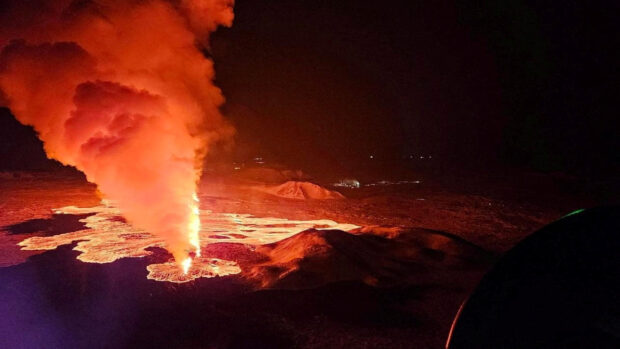Iceland volcano erupts with lava fountains, disrupts heating and roads

A volcano spews lava and smoke as it erupts on Reykjanes Peninsula, Iceland, February 8, 2024. Iceland Civil Protection/Handout via REUTERS
NORTH OF SYLINGARFELL, Iceland — A volcano in southwestern Iceland erupted on Thursday for the third time since December, spraying streams of lava up to 80 meters (260 feet) into the air and triggering an emergency warning as thousands of households lost heating in the middle of winter.
Bright orange molten rock spewed from cracks in the ground in the Reykjanes peninsula and lava crossed a road near the Blue Lagoon – a luxury geothermal spa – which had to close due to the eruption.
The intensity of the outbreak had eased by Thursday afternoon, said the Icelandic Met Office which is tasked with monitoring volcanoes.
Still, the lava flow hit water pipes in the region just south of the capital, disrupting the supply of geothermally-heated water used to warm homes and leading the Civil Protection Agency to raise its alert level to emergency status.
READ: Iceland volcano erupts again, molten rocks spew from fissures
Article continues after this advertisementReykjavik’s Keflavik Airport also lost access to hot water but said it had otherwise maintained operations as usual.
Article continues after this advertisementThe temperature in the area stood at -7 degrees Celsius (19 degrees Fahrenheit) and was forecast to drop to -10 degrees Celsius (14 degrees Fahrenheit) in the evening.
Rikke Pedersen, who heads the Nordic Volcanological Centre research group based in Reykjavik, said more than 20,000 people had lost access to hot water.
The Civil Protection Agency asked people in the affected area to only use one small electrical heater per households to prevent blackouts.
Restoring hot water via an emergency pipeline that was already under construction could take days, it said.
Volcanic outbreaks in the Reykjanes peninsula are so-called fissure eruptions, which do not usually cause large explosions or significant dispersal of ash into the stratosphere.
READ: Volcano erupts in Iceland, flowing lava reaches fishing town
However, scientists fear they could continue for years, and Icelandic authorities have started building dykes to divert burning lava flows away from homes and critical infrastructure.
The lava stream also came within 1 km (0.6 miles) of the peninsula’s Svartsengi geothermal power plant, Pedersen said.
As the lava flowed, workers were trying to fill in gaps in the protective dykes built along the road.
“So they are really doing all they can to prevent lava reaching the power plant,” she said.
History of eruptions
The latest eruptive fissure, the sixth outbreak since 2021, was roughly 3 km (2 miles) long, Iceland’s meteorological office said. Intense earthquake activity began around 5:30 a.m. and the eruption itself 30 minutes later.
A plume of smoke rose 3 km into the air, according to the Met Office.
Reykjanesbaer, Iceland’s fifth largest municipality, said it would close all kindergartens and schools on Friday.
The previous eruption in the area started on Jan. 14 and lasted roughly two days, with lava flows reaching the outskirts of the Grindavik fishing town, whose nearly 4,000 inhabitants had been evacuated, where some houses were set alight.
READ: Iceland prepares for volcanic eruption in coming days
Thursday’s eruption took place some way from Grindavik and was unlikely to pose a direct threat to the town, Icelandic geophysicist Ari Trausti Gudmundsson told Reuters.
Iceland’s President Gudni Johannesson posted an image of flames and smoke in the distance on social media, saying that was the view from his residence.
“As before, our thoughts are with the people of Grindavik who cannot reside in their beautiful town. This too shall pass,” Johannesson wrote.
Despite downgrading the volcanic system’s threat level, authorities have warned of further eruptions as land continued to rise in the area due to magma accumulating underground.
The Reykjanes peninsula alone has six active volcanic systems and could see eruptions on-and-off for decades or potentially even centuries, Gudmundsson said.
Other parts of the country have more powerful volcanoes.
READ: ‘Indescribable’: the heat and roar of Iceland’s volcano
In 2010, ash clouds from eruptions at Eyafjallajokull in the south of Iceland spread over large parts of Europe, grounding some 100,000 flights and forcing hundreds of Icelanders to evacuate homes.
But unlike Eyafjallajokull, the Reykjanes volcano systems are not trapped under glaciers and are thus not expected to cause similar-sized ash clouds.
Iceland, which is roughly the size of the U.S. state of Kentucky, boasts more than 30 active volcanoes, making the north European island a prime destination for volcano tourism – a niche segment that attracts thousands of thrill seekers.